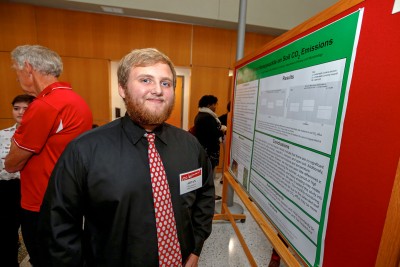It's Inauguration Day!
Congratulations, Matt vandenBerg, OWU's 17th President!
View details for Inauguration Day and stream the event live.
Congratulations, Matt vandenBerg, OWU's 17th President!
View details for Inauguration Day and stream the event live.

 Student: Aidan Shumaker
Student: Aidan Shumaker
Faculty Mentor: Laurel Anderson (OWU Department of Botany and Microbiology)
In Dr. Anderson’s lab we are studying greenhouse gas emissions underneath invasive Amur Honeysuckle and native Spicebush shrub species. We want to know whether or not soils under honeysuckle emit more greenhouse gasses than soils under native shrubs, possibly affecting local and global warming. This may occur because invasive honeysuckle has early leaf production and keeps its leaves longer than most native plants, and has higher leaf nitrogen, possibly stimulating longer root activity and greater decomposition by microbes, which could increase gas emissions. Our research will contribute to a better understanding of the impacts of invasive species on a local or even global scales.
Lonicera maackii is an invasive woody species found in Ohio and throughout the deciduous forests of eastern United States, taking over habitats of native shrub species such as Lindera benzoin. L. maackii has unique traits compared to deciduous forest natives, showing earlier leaf-out and later leaf senescence, higher leaf nitrogen levels, and faster leaf decomposition. As a result, L. maackii may alter soil conditions through its extended root activity and impacts on microbial decomposition, possibly impacting soil CO2 emissions. As soil microorganisms metabolize organic matter, they release greenhouse gases like CO2 through respiration, which can impact global climate change. Previous research has shown that microbial respiration under an invasive shrub of the mediterranean coastal dunes was significantly altered compared to the native species of this ecosystem, indicating a possible total increase of greenhouse gas emissions. However, the effects of L. maackii on soil respiration have been understudied, with no considerations towards the possible effects of this shrub on local forest greenhouse emissions. To monitor CO2 emissions underneath L. maackii, a LI-COR LI-6400 was used to measure CO2 efflux using PVC soil collars embedded into the soil. These measurements were compared with soil efflux data collected from beneath native L. benzoin as well as patches of open soil at least 1 m away from the canopy dripline of any shrub. Soil respiration measurements collected in June 2018 showed no significant difference in CO2 emissions among the three soil conditions. However, since the measurements have only been taken in the summer, the high productivity of both native and invasive plants during this season may explain these similarities. More measurements across all seasons will be collected later to assess if L. maackii impacts soil respiration at other times, particularly when this species experiences early leaf-out and late senescence and native plants are dormant.